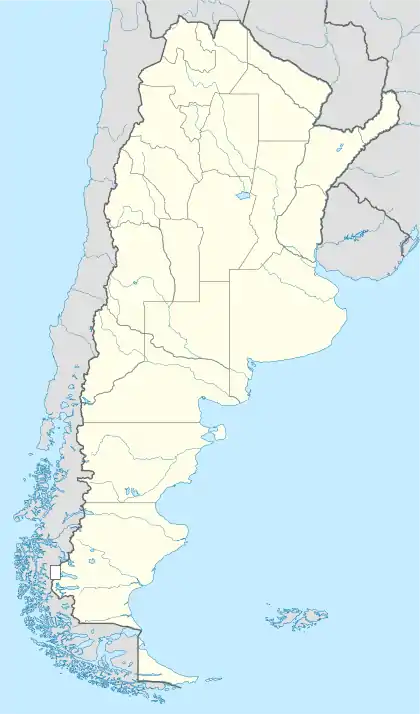San Martín, Mendoza
San Martín is a city in the north-center part of the Mendoza Province in Argentina. It is the capital of the San Martín Department and constitutes, with Palmira and La Colonia, the third-largest metropolitan area in the province.
San Martín | |
|---|---|
 City Hall San Martín | |
 San Martín Location of San Martín in Argentina | |
| Coordinates: 33°04′50″S 68°28′14″W | |
| Country | |
| Province | |
| Department | San Martín |
| Founded | December 20, 1816 |
| Founded by | Toribio de Luzuriaga (Governor of Mendoza) |
| Area | |
| • Total | 1,504 km2 (581 sq mi) |
| Elevation | 770 m (2,530 ft) |
| Population (2010 census) | |
| • Total | 79,476 |
| • Density | 53/km2 (140/sq mi) |
| Time zone | UTC-3 (ART) |
| CPA base | M5570 |
| Dialing code | +54 02623 |
| Climate | BWk |
History
The first San Martín inhabitants were the Huarpe Milkayak people. The territory was governed by the tribal chief called Pallamay until 1563, when the first Europeans under the command of the Captain Pedro Moyano Cornejo, arrived to the area.
The city was known as Rodeo de Moyano or, alternatively, as La Reducción (Spanish: The Reduction); but its name was changed to Villa Los Barriales in 1816, when it was included in the Corocorto Priesthood of Mendoza Province and officially established by the Governor of Mendoza, Toribio de Luzuriaga.
San Martín came into prominence in the war of the Argentine independence period, when José de San Martín received an extensive land grant in the area to take advantage of agriculture and help the Chilean army of Bernardo O'Higgins in an effort to prevent new Spanish invasions from Chile to Argentina. In 1823, the governor Pedro Molina changed the name of the city yet again in homage to the Argentine general José de San Martín,[1] who, besides his inestimable historical role, contributed many innovations to the local farming sector and in viticulture, particularly.
In 1885, the first railway arrived in San Martin, uniting Buenos Aires with Mendoza and Chile. This development brought many Italian immigrants to the area from Buenos Aires; during the 1950s and '60s, National Route 7 was built between Buenos Aires and Mendoza Province, converting the city into an important distribution center along the most important highway between Buenos Aires and Santiago, Chile.
Climate
| Climate data for San Martín, Mendoza (1981–2010, extremes 1961–2016) | |||||||||||||
|---|---|---|---|---|---|---|---|---|---|---|---|---|---|
| Month | Jan | Feb | Mar | Apr | May | Jun | Jul | Aug | Sep | Oct | Nov | Dec | Year |
| Record high °C (°F) | 42.7 (108.9) |
40.6 (105.1) |
37.0 (98.6) |
33.6 (92.5) |
31.6 (88.9) |
30.1 (86.2) |
32.1 (89.8) |
33.5 (92.3) |
35.7 (96.3) |
40.4 (104.7) |
40.5 (104.9) |
43.3 (109.9) |
43.3 (109.9) |
| Average high °C (°F) | 32.4 (90.3) |
31.1 (88.0) |
28.1 (82.6) |
23.5 (74.3) |
19.1 (66.4) |
15.7 (60.3) |
15.4 (59.7) |
18.6 (65.5) |
21.5 (70.7) |
26.0 (78.8) |
29.2 (84.6) |
31.7 (89.1) |
24.4 (75.9) |
| Daily mean °C (°F) | 24.6 (76.3) |
23.2 (73.8) |
20.5 (68.9) |
15.6 (60.1) |
11.3 (52.3) |
8.0 (46.4) |
7.5 (45.5) |
10.2 (50.4) |
13.3 (55.9) |
18.0 (64.4) |
21.3 (70.3) |
23.9 (75.0) |
16.5 (61.7) |
| Average low °C (°F) | 17.8 (64.0) |
16.5 (61.7) |
14.8 (58.6) |
10.1 (50.2) |
6.1 (43.0) |
2.7 (36.9) |
1.9 (35.4) |
4.0 (39.2) |
6.8 (44.2) |
11.0 (51.8) |
14.0 (57.2) |
16.8 (62.2) |
10.2 (50.4) |
| Record low °C (°F) | 5.3 (41.5) |
4.0 (39.2) |
−1.4 (29.5) |
−2.8 (27.0) |
−6.6 (20.1) |
−8.2 (17.2) |
−9.4 (15.1) |
−7.0 (19.4) |
−5.2 (22.6) |
−1.9 (28.6) |
−0.3 (31.5) |
2.4 (36.3) |
−9.4 (15.1) |
| Average precipitation mm (inches) | 45.0 (1.77) |
36.3 (1.43) |
43.0 (1.69) |
15.8 (0.62) |
9.2 (0.36) |
3.7 (0.15) |
6.8 (0.27) |
6.4 (0.25) |
12.4 (0.49) |
12.7 (0.50) |
20.1 (0.79) |
28.4 (1.12) |
239.8 (9.44) |
| Average precipitation days (≥ 0.1 mm) | 6.3 | 5.5 | 4.4 | 2.6 | 2.2 | 1.4 | 1.9 | 1.6 | 2.7 | 2.2 | 3.7 | 5.3 | 39.8 |
| Average relative humidity (%) | 55.5 | 59.2 | 66.4 | 69.8 | 70.6 | 69.9 | 65.0 | 56.7 | 54.7 | 51.3 | 51.1 | 51.5 | 60.1 |
| Source: Servicio Meteorológico Nacional[2][3] | |||||||||||||
See also
References
Notes
- San Martín was the first city in South America named in homage to José de San Martín.
- "Estadísticas Climatológicas Normales - período 1981-2010" (in Spanish). Servicio Meteorológico Nacional. Retrieved January 21, 2018.
- "Clima en la Argentina: Guia Climática por San Martín (Mza.)". Caracterización: Estadísticas de largo plazo (in Spanish). Servicio Meteorológico Nacional. Archived from the original on 4 September 2017. Retrieved 5 October 2017.
External links
| Wikimedia Commons has media related to San Martín (Mendoza). |
- (in Spanish) Official Site
- (in Spanish) Atlético Club San Martín
- (in Spanish) San Martín Tourism Guide
- Vineyards in the East Zone of Mendoza (in English, Spanish, German, French, Italian, and Portuguese)